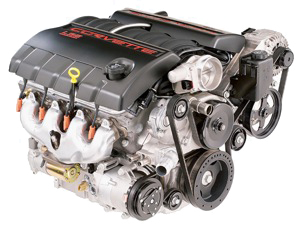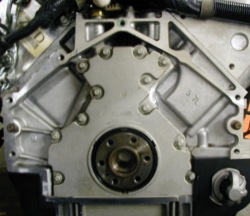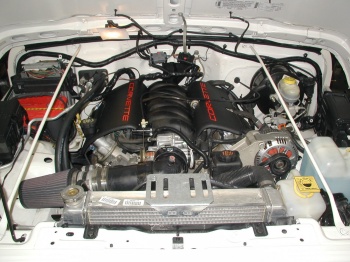The Novak Guide to the
GM Generation III+ V8 Engines

The GM Generation III & IV Engine
It takes serious guts to replace the most famous engine of all time. Since 1955 GM had been building is Chevrolet Small Block V8 with accolades, respect and awards in the automotive press and racing and with commercial success with customers in marine, industrial and mainstream automotive markets. The Small Block was the most purchased, modified and swapped engine of all time.
The Gen III has now become the predominant swap engine into nearly all Jeep vehicles.
Development
Research into what would become the Gen. III began in 1991. It took engineers two years to conclude that they could extend the life of the classic Small Block with several surrounding technologies (that were eventually rolled into LT and other Small Blocks), but they realized that they would soon hit a wall without an actual fundamental redesign of the flagship GM V8's.
 Just like the Small Block used a then-innovative green sand casting method in its block founding process, the Gen. III uses an innovative lost-foam block founding process. The result is a very high resolution, strong and affordably manufactured block.
Just like the Small Block used a then-innovative green sand casting method in its block founding process, the Gen. III uses an innovative lost-foam block founding process. The result is a very high resolution, strong and affordably manufactured block.
The Result
Thus, GM engineers accepted the challenge to get all of the broad performance and efficiency out of a single-cam, pushrod and hydraulic lifter engine with two valves per cylinder that other manufacturers were getting out of complex DOHC multi-valve engines.
The eventual result was a phenomenon.The engine profited from the excellent simplicity and elegant engineering built into the design since the inception of the Small Block in 1955. In fact, the motor produces more power more efficiently than multi-cam engines that cost significantly more to build. In terms of engineering, GM Powertrain has added a distinguished feather to their caps.
The introduction of the Gen. III motor in 1997 was actually understated, and it may have been this was so as to not lose the loyal adherents of the original Small Block. It was not until these motors got into the hands of enthusiasts that they began to realize the importance of what GM had done:
- decreased rotating mass for quicker revs
- decreased ring friction, yet with better oil / compression control
- deeper engine skirt for increased engine rigidity for a decrease in distortion for less noise, friction, wear
- six-bolt main bearing caps in lieu of two & four-bolt caps
- head design increases volumetric efficiency, therefore more power at all engine speeds
- quieter and more efficient valve train operation
- new firing order for smoother idle and less vibration throughout the operational range
- sequential fuel injection
- elimination of Exhaust Gas Recirculation (most engines) by achieving a more complete burn the first time
- coil-near-cylinder design; shorter plug wires for a double-hot spark
- one coil per spark plug; individual cylinder timing can be tuned on the fly via the PCM and knock sensing
- powerful and reliable powertrain control computer with the ability to holistically control more engine (and automatic transmission) processes than ever
- throttle-by wire (most models)
- all models are internally balanced without any need for balance shafts, etc.
- better sealing methods at the engines covers and mating components
- displacement-on-demand (DOD) that senses cruising modes and shuts down operation of cylinders for increased fuel economy (starting in some models in 2005)
- same overall size as the original Small Block, offering tremendous power output for such a compact size envelope
- 400,000 mile longevity design
- rod bearings
- the 4.4" center-to-center specs on piston bores
- the block's rear face bolt pattern
The crank featured larger main bearing journals. The connecting rods are made with an innovative new process with powdered metal, forged and then shot-peened. These rods are stronger and more balanced that previous methods would allow.
The intake on the LS1 and subsequent engines is made of a composite, reinforced nylon material. This allows for perfectly equal length and volume intake runners, smoother runner walls and better manufacturing economics over previous cast steel and aluminum styles. Our experience is that the low-profile intakes can swap for the high-profile intakes in the event that hood clearance is an issue (such as with the Jeep XJ Cherokee or other "low-hood" conversions) but that special computer tuning work is required.
In 2001, GM - for the first time since 1955 - changed the crank depth and its pilot bore diameter of the Gen. III. Pilot bushings differ for these motors and transmissions built from this time forward had a deeper bellhousing and different torque converter.

The 5.7L LS1 - the seminal engine for the Gen. III - and it's rear face, which is identical to the classic SBC of fifty years ago. This is just one of many things that makes GM so respected in the conversion world.
Though many technologies carried over from the LT engines, the Gen. III+ motors do not use reverse flow cooling. GM engineers decided that potential hot spots against the cylinder walls was a greater concern than detonation caused by high compression and hot heads.
The Gen. IV engines were introduced in 2004 are very similar to the Gen. III motors, but include a few new technologies; key ones include Active Fuel Management (also called Displacement On Demand) and Variable Valve Timing.
List of GM's Gen 3+ Engines
We've assembled a brief list of engines. Some are less preferable for Jeep conversions for obvious cost and horsepower insanity reasons. 4.8L, 5.3L and some 6.0L as sourced from truck/SUV platforms are the most popular and sensible conversions for most Jeeps.
| Engine | Displacement | Years | HP | Torque | notes |
| LS1 | 5.7L | 97- | 305-345 | The groundbreaking Gen. III engine, released in C5 Corvette | |
| LS2 | 6.0L | 05- | 400 | 400 | 2005- Vette & GTO |
| LS3 | 6.2L | 08 | 430 | 424 | 436 HP with exhaust bypass option |
| LS4 | 5.3L | 04- | 303 | 323 | One version available for transverse FWD Pontiac GXP |
| LS6 | 5.7L | 01-05 | 385-405 | 385-400 | |
| LS7 | 7.0L | 06-07 | 505 | 470 | Hand-built. LS7R version voted Engine of the Year by jury of race engineers |
| LM7 | 5.3L | 99-07 | 285-295 | 325-335 | G3. Possibly the most popular Jeep swap engine, currently |
| LM4 | 5.3L | 04 | 295 | 335 | G3. Aluminum block version |
| L33 | 5.3L | 05-07 | 310 | 335 | G3. HO aluminum block version |
| L59 | 5.3L | 02-07 | 285-295 | 325-335 | Flex-Fuel engine. Can be installed in a Jeep but more complex |
| LH6 | 5.3L | 05-07 | 315-320 | 340 | G4. Aluminum block |
| LY5 | 5.3L | 07 | 315-320 | 340 | G4. Iron block |
| LMG | 5.3L | 07 | 315-320 | 340 | Flex-Fuel |
| LC9 | 5.3L | 07 | 310 | 335 | Flex-Fuel, aluminum block. Envoy models have front differential provisioned oil pan |
| LQ4 | 6.0L | 02-07 | 300-325 | 360-370 | Base level 6.0L with iron block |
| LQ9 | 6.0L | 02-07 | 345 | 380 | HO or VortecMAX version |
| LY6 | 6.0L | 07 | 312-353 | 373-383 | Aluminum block, variable valve timing, |
| L92 | 6.2L | 07 | 380-403 | 415 | Aluminum block, VVT, |
| LR4 | 4.8L | 03- | 270-285 | 285-290 | G3. VVT. AFM |
| LY2 | 4.8L | 07- | 295 | 305 | G4. No VVT or AFM |
Flywheels and Bellhousings

An LS1 in a Jeep TJ Wrangler. Vortec and other Gen. III+ engine installations similar.
5.3L engines are usually only factory available with the flexplate that mates to the 4L60E transmission (a very popular transmission choice of our customers) and these motors were not available with a flywheel. However, 4.8L and 6.0L flywheels do interchange onto the 5.3L as the cranks are of a unified design and all Gen. III motors are internally balanced.
Flywheels and flexplates from Gen. I and Gen. II engines will not and must not be married to any Gen. III+ crank.
The Gen. III+ engines all use a block-mounted starter, in lieu of a bellhousing-mounted starter as done by other auto companies.
As stated earlier, the standard shift Chevrolet bellhousing designs from the previous 50 years will marry to the engine block of these new engines.
Further interchange information is found here.
Transmission Compatibility
The Gen. III / IV engines are compatible with essentially every transmission, manual or automatic, as the Small Block V8. Some popular choices in Jeeps include:
Manuals, non-native upgrades
 |
 |
 |
 |
||
| SM420 (*) | SM465 (*) | Ford T18 (**) | Ford NP435 (**) | ||
|
* Preferred
** Possible with modifications |
|||||
Manuals, Jeep native
 |
 |
 |
 |
 |
| T90 | T150 | T176 | AX15 | NV3550 |
Automatics, non-native upgrades
 |
 |
 |
 |
| TH350 | TH400 | TH700R4 / Early 4L60-E | 4L60-E (later) |
|
All Gen. III / IV engines are best paired or pulled with the same year of engine and PCM. PCM controlled engines getting a non-electronic automatic transmission should have their PCM programmed as if paired with a manual transmission. The 4L60E automatic is typically the best choice of automatic for nearly all Jeeps.
|
|||
Conclusion
The interesting dynamic was that of the semi-cooperating / semi-competing style of these divisions with and against each other. Each of these divisions had their strengths in their products and certainly they appealed to the different styles and interests of a broad range of people. Through the seventies and eighties, we see a pronounced increase in the pace of consolidation and elimination of powertrain components, and especially in engines - a trend that was started in the fifties in the transmission divisions of GM.
Today, the engines and transmissions are managed under the GM Powertrain division. The V8’s that came out on top were the Chevrolets. Buick’s V6 dominates cleanly with the 3800 V6, with a close second to Chevrolets V6 for trucks. Cadillac remains somewhat apart. Some would say they are the R&D portion of GM where the more advanced technologies are tested.
The point in this very abbreviated history is that the commonality of these engines makes the swap easier to understand and, as stated earlier, better supported by the aftermarket in parts and knowledge. To boot, the combined knowledge of engines from the different divisions has blended together to create some very outstanding engines.
One is tempted to believe that the gasoline engine has reached its nirvana with the Gen. III+ engines as engineered and built by GM. When considered with the power, cost, package size, fuel efficiency and longevity, these world-class engines can compete with and beat - with flying colors in most cases - essentially any automotive power plant available. The fact that one of these engines can be installed into a Jeep with such success makes the decades-rich tradition of engine swapping more exciting than it has ever been.
This article is only a synopsis and a wealth of information on these engines exists from a multitude of sources. However, to remain germane to our topic, we've kept it brief.
Sources
- The Novak archives and installation projects
- Novak customers and their project input
- Wikipedia
- GM Powertrain
We welcome any contributions or clarifications to this article. Contact us here.




